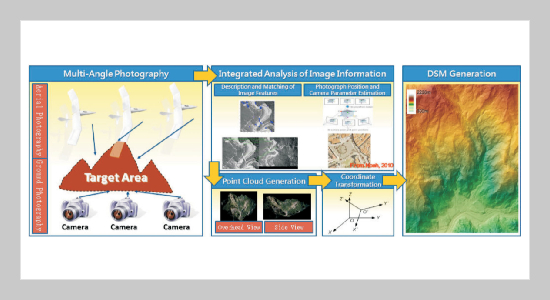Chien-Ting Wu This email address is being protected from spambots. You need JavaScript enabled to view it.1, Cheng-Yang Hsiao2 and Chun-Sung Chen3 1Department of Civil Engineering, National Chiao Tung University, Hsinchu, Taiwan 300, R.O.C.
2Disaster Prevention Technology Research Center, Sinotech Engineering Consultants, Inc., Taiwan 300, R.O.C.
3Department of Geomatics, Chien Hsin University of Science and Technology, Taoyuan, Taiwan 320, R.O.C.
Received:
May 17, 2012
Accepted:
January 7, 2013
Publication Date:
June 1, 2013
Download Citation:
||https://doi.org/10.6180/jase.2013.16.2.01
Unconventional photogrammetric measurement technology, which offers features that include no specific camera measurement requirements, few constraints and the ability to take images with different types of equipment, has been used in recent years for emergency natural disaster size assessment and planning disaster relief and mitigation. However, the measurement errors associated with unconventional photogrammetric measurement technology have thus far not been standardized as have those associated with traditional photogrammetric technology. Using the Typhoon Morakot disaster area as a study area, this study used unmanned aerial vehicles (UAV) to overcome the limits of ground photographic shooting angles to conduct low-elevation photography of sediment disaster areas. Using unconventional photogrammetric measurement technology in the field of computer vision, this study established post-disaster environmental three-dimensional terrain data. With the maturation of virtual-base-station real-time kinematic (VBS-RTK) technology in recent years, it was possible in this study to conduct real-time positing by reference to ground control targets to meet goals concerning rapid assessment of disaster situations and disaster relief horizontal accuracy. In addition to introducing relevant technological integration methods, this study explored the technology’s data accuracy and its applications. The empirical results suggest that the horizontal accuracy of the technology studied is within 50 cm and the elevation accuracy is within 1 meter in most cases. Hence, the unconventional photogrammetric measurement technology described in this paper is suitable for use in making quantitative calculations of topographic data from sediment disaster regions as well as rapid disaster relief judgments.ABSTRACT
Keywords:
Unmanned Aerial Vehicles (UAV), VBS-RTK, Computer Vision, Accuracy
REFERENCES









